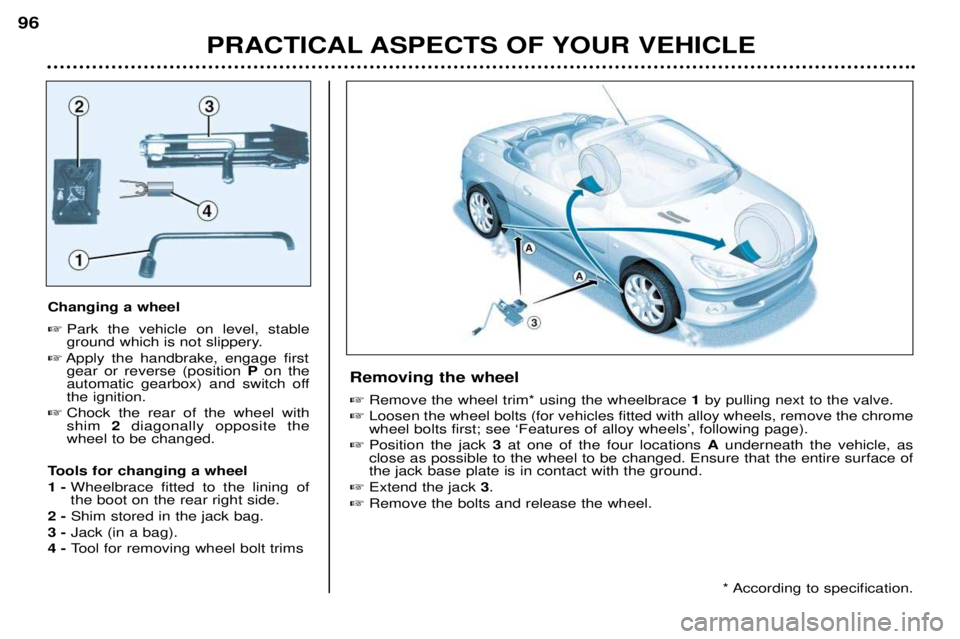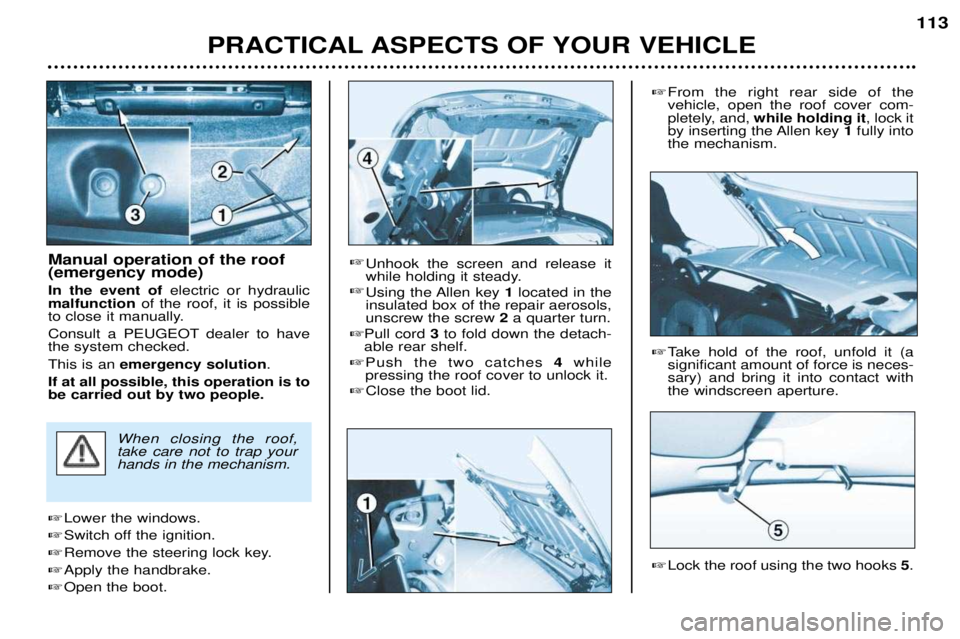Page 85 of 123

YOUR 206 CC IN DETAIL85
Automatic autoadaptive gearbox* Moving Off
To move off, move the selector lever to position
Nor P. Press the brake to exit
position P. Stopped or parked Always leave the lever in position Pwhen you get out of your vehicle.
If not, a buzzer will sound when you open the driver's door.
Positions of the selector lever These positions are displayed on the instrument panel.P �
�Park: use with the handbrake when parking
R �
�Reverse: this must only be engaged when the vehicle is stationary, engine at idle.
N �
�Neutral: if
Nis engaged by mistake while the car is moving, allow the
engine to return to idle before engaging a new forward gear.
D �
�Drive: in this position, the four gears change automatically. The gear change points vary depending on the programme selected.
3 �
��
Automatic changes of the first three gears only. Select this position when you notice frequent changes between third and fourth gear (town driving oron winding roads).
2 �
��
Automatic changes of the first two gears only. This position is particularly suitable for mountain roads, when going uphill (to make the best use of theengine's power) and downhill (engine braking).
* According to specification .
Page 86 of 123

YOUR 206 CC IN DETAIL
86
Operating programmes
You have a choice of three operating pro- grammes:
Ð Autoadaptive (normal).
Ð Sport.
Ð Snow.One press on button
Aor Bwill select
Sport or Snow respectively. The selec- tion is displayed on the instrumentpanel. Pressing the button a secondtime will return to the autoadaptive(normal) programme. Autoadaptive programme (normal) Gear changes are carried out on the basis of various parameters, such as:
Ð driving style,
Ð road characteristics,
Ð vehicle load.The gearbox continuously scans the
different programmes in the memoryand selects the one most suitable forthe driving conditions at any givenmoment. Sport programme The Sport programme automatically favours more dynamic driving. Snow Programme In position
D, the Snow programme
provides smooth driving suited to slip- pery roads in order to improve traction
and stability. Starting is in 2nd gear
and changing down is at low enginespeeds. Special operating features
Ð During prolonged braking, the gearbox changes down automatically, so as to
provide efficient engine braking.
Ð If you take your foot off the accele- rator suddenly (when you are takenby surprise, for example), the gear-box will not change up, so as to
improve safety.
Ð When the engine is cold, the gear- box automatically selects a specialprogramme that enables the engineto reach its ideal temperature more quickly in order to decrease pollu-tion.
Kickdown For immediate maximum acceleration
without touching the gear lever, press theaccelerator pedal down as far as it will go.The gearbox will change down automati-cally or stay in the gear selected, up tomaximum engine speed.Any disruption of the system is signalled by the simulta-neous flashing of the Sportand Snow lights on the ins-
trument panel. In such a case, thegearbox will operate in downgrade
mode. You may feel a substantialknock when reverse is selected from P
to Ror Nto R(without any risk of
damage to the gearbox). Do not exceed 60 m.p.h. (100km/h).Contact a PEUGEOT dealer without
delay. When the engine is idling with the car
in gear, the car will move even withoutyou accelerating. Do not accelerate while a gear is being
selected, when the vehicle is stationary.
When stationary, have your foot on the
brake pedal when selecting a gear. Do not accelerate in gear with the brakes on. If work needs to be done with the engi- ne running, apply the handbrake andselect position P.
Do not change down to brake on slip-pery roads. Never select position Nwhen the
vehicle is moving.Never engage Por Rif the vehicle is
not stationary.Do not leave children inside the vehicle unsupervised when the engineis running.
Page 87 of 123
YOUR 206 CC IN DETAIL87
The normal operation of the ABS may make itself felt by slight vibra-tions of the brake pedal. In emergency braking, press very firmly without releasing thepressure.
The ABS Anti-lock Braking System*
When used with approved tyres in
good condition, the ABS increases thestability and manoeuvrability of yourvehicle, particularly on poor or slipperyroad surfaces. The anti-lock braking system comes into operation automatically whenthere is a risk of wheel lock.
Handbrake Locking When parking, pull the handbrake to immobilise your vehicle. Unlocking Pull the handle and press the button to release the handbrake.
* According to specification.
Page 98 of 123

PRACTICAL ASPECTS OF YOUR VEHICLE
96
Changing a wheel �
Park the vehicle on level, stable
ground which is not slippery.
� Apply the handbrake, engage first
gear or reverse (position Pon the
automatic gearbox) and switch offthe ignition.
� Chock the rear of the wheel withshim 2diagonally opposite the
wheel to be changed.
Tools for changing a wheel 1 - Wheelbrace fitted to the lining of the boot on the rear right side.
2 - Shim stored in the jack bag.
3 - Jack (in a bag).
4 - Tool for removing wheel bolt trims Removing the wheel �
Remove the wheel trim* using the wheelbrace 1by pulling next to the valve.
� Loosen the wheel bolts (for vehicles fitted with alloy wheels, remove the chrome wheel bolts first; see ÔFeatures of alloy wheelsÕ, following page).
� Position the jack 3at one of the four locations Aunderneath the vehicle, as
close as possible to the wheel to be changed. Ensure that the entire surface ofthe jack base plate is in contact with the ground.
� Extend the jack 3.
� Remove the bolts and release the wheel.
* According to specification.
Page 99 of 123
PRACTICAL ASPECTS OF YOUR VEHICLE97
Refitting the wheel �
After positioning the wheel, pre-tighten the bolts using the wheelbrace 1.
� Compress the jack 3and release it.
� Fully tighten the bolts using the wheelbrace 1.
� Replace the wheel trim*, starting at the valve passage hole, and press on it using the palm of the hand.
Replace the shim and the jack in their bag, then store the tools in the boot.For your safety, always change the wheel:
- on level, stable and non-slippery ground,
- with the handbrake applied and the ignition switched off,
- with the first or reverse gear engaged (position Pfor the auto-
matic gearbox),
- with the vehicle chocked using a shim.
Never go underneath a vehiclewhich is supported only by a jack(use an axle stand) .
After changing the wheel:
- As soon as possible contact a PEUGEOT dealer to check that the wheel bolts are tight.
* According to specification.
Page 117 of 123

PRACTICAL ASPECTS OF YOUR VEHICLE113
Manual operation of the roof (emergency mode) In the event of
electric or hydraulic
malfunction of the roof, it is possible
to close it manually.
Consult a PEUGEOT dealer to have the system checked. This is an emergency solution .
If at all possible, this operation is to be carried out by two people. � Lower the windows.
� Switch off the ignition.
� Remove the steering lock key.
� Apply the handbrake.
� Open the boot.�
Unhook the screen and release it
while holding it steady.
� Using the Allen key 1located in the
insulated box of the repair aerosols,unscrew the screw 2a quarter turn.
� Pull cord 3to fold down the detach-
able rear shelf.
� Push the two catches 4while
pressing the roof cover to unlock it.
� Close the boot lid.
�From the right rear side of the vehicle, open the roof cover com-
pletely, and, while holding it , lock it
by inserting the Allen key 1fully into
the mechanism.
� Lock the roof using the two hooks 5.
When closing the roof, take care not to trap yourhands in the mechanism.
� Take hold of the roof, unfold it (a significant amount of force is neces-sary) and bring it into contact withthe windscreen aperture.